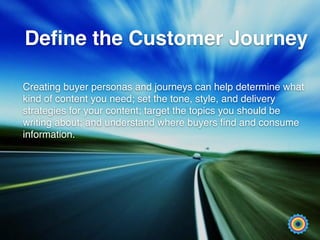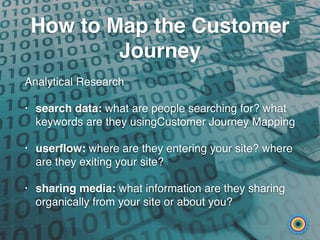Developing Personas for Effective Marketing
- 1. Developing Personas for Effective Marketing Marisa Peacock The Strategic Peacock
- 2. What Are Marketing Personas? In user-centered design and marketing, personas are fictional characters created to represent the different user types that might use a site, brand, or product in a similar way
- 3. How Are Personas Used in Marketing? To better target their marketing messages, marketers have used customer acquisition and past buying behavior data to better understand their audience in terms of demographics, psychographics and interests.
- 4. How to Create Marketing Personas
- 5. Identify Target Audiences • Where does your audience live online? • Is your current audience your target audience? • What behaviors does your audience exhibit? • What types of content do they engage with? • What problems do they have? What interests them?
- 6. Use Tools to Gather Intelligence • Hootsuite Plug-in: demographics pro • Demographics Pro (Paid version) • Social Bro (Twitter Only) • Twitter, Facebook Insights • Simply Measured’s free tools
- 7. Who is your persona? • What is his/her name and age? • What does s/he look like and how does s/he dress? • What level of education does s/he have? • Where is s/he located? Is it a city or the country? • What are his/her living arrangements?
- 8. What does your persona do for a living? • What is his/her job? • Is his/her identify tied to his/her work or profession? • How much money does s/he make? • What are his/her feelings towards money? Is s/he a penny pincher or generous? • Does s/he keep a budget? Does s/he save or invest money on a regular basis? • How does s/he pay for purchases? Does s/he use cash, debit cards, credit cards or electronic payment systems?
- 9. What are the persona’s non- work interests and/or hobbies? • What are his/her hobbies? Are they outwardly or inwardly focused? • Is the persona healthy? If not, what type of health issues does s/he have and how do they effect /her life? • What does the character believe with regard to politics, religion and other major issues?
- 10. Define the Customer Journey Creating buyer personas and journeys can help determine what kind of content you need; set the tone, style, and delivery strategies for your content; target the topics you should be writing about; and understand where buyers find and consume information.
- 11. Customer Journey Mapping A customer journey map tells the story of the customer’s experience: from initial contact, through the process of engagement and into a long-term relationship.
- 12. How to Map the Customer Journey Analytical Research • search data: what are people searching for? what keywords are they usingCustomer Journey Mapping • userflow: where are they entering your site? where are they exiting your site? • sharing media: what information are they sharing organically from your site or about you?
- 13. How to Map the Customer Journey Anecdotal Research • customer service data: talk to your salespeople, call agents, receptionists? What are the FAQs, biggest pain points? • talk to customers: what do they want to find? where do they want to find it?
- 14. Just Map It! • Where do they start their search? (online search, social media, website, mobile devices, offline, phone, email, etc) • What do they want? (how much it costs, what it does, who’s involved, technical specs, photos & video) • What call to action appeals most to them? (read more, learn more, give now, download, watch, contact us, etc) • What happens after they accomplish their goals? (email follow-up, sign up for newsletter, phone call, text message, social media shout-out, etc)
- 15. Manage & Track • After you’ve identified your user personas and mapped their customer journeys, keep track of their experiences — set tangible and intangible goals. • How will you know if everything is working? What will it look like? What analytics and anecdotal evidence will you look for?















